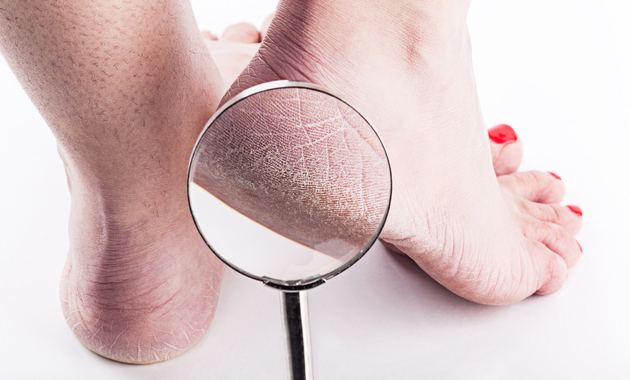
Cracked heels are one of the common foot problems which can affect people of all ages. However, it is seen to affect women more than men. There are numerous causes of cracked heels which can range from lack of moisture and wearing wrong footwear to certain health conditions such as diabetes. Here’s more on the causes of cracked heels.
7 Common Causes Of Cracked Heels
1. Prolonged standing
One of the reasons why you experience cracked heels is standing for too long. Prolonged standing, especially on hard floors can increase the pressure on the heels and also lead to constant friction, which may lead to cracks and open sores. This if left unattended can cause severe heel pain and may also lead to bleeding. If you have a job profile that requires you to stand for long, then you must wear proper-fitting footwear with adequate cushioning to ease the pressure on the heels.
2. Walking barefoot
Most of us might have heard that walking barefoot on grass is a good idea. However, walking barefoot can cause accumulation of dirt in the foot which can increase the risk of a cracked foot. Also, the use of open-back sandals can allow fat under the heel to expand which in turn can increase the possibility of cracked heels. Moreover, wearing ill-fitting shoes can also contribute to cracked heels and heel pain.
3. Aging skin
As you age, so does the skin. Hence, people who are old tend to have thick and dry skin. This is because, as you become old, the skin loses its elasticity. It causes the skin to become more dry, rough and scaly. Also, the production of oil to prevent moisture is also decreased which further increases the risk of cracks, especially in the feet, causing cracked heels.
4. Poor hygiene
Just like our face, our feet are also exposed to a lot of dust, pollution, and chemicals. So it goes without saying that we have to take care of our feet the same way as we do it for our face. This includes washing the feet with water every time you enter your house to remove dirt and scrubbing the feet quite often than not to remove dead skin cells. Also, applying moisturizer, especially during winters to keep the feet moisturized is also a part of foot care to maintain proper hygiene.
5. Dry skin
There are numerous factors that increase your risk of dry skin. The common ones include cold temperature, especially during winter, which rips off moisture from the air. The low humidity levels can make you more prone to dry skin. Moreover, the skin underneath the feet is often dry, rough and chapped. As the skin around the heels has a relatively small number of seta glands, it is at high risk of becoming dry. Hence, during winters and lack of proper hydration can leave the skin drier and increase the risk of cracked heels.
6. Obesity
If you are overweight or obese, then simply standing on your feet can increase the pressure on the fat pad under the heel. This can cause the area to expand sideways which can lead to cracked heels. Moreover, if the skin is not supple and lacks flexibility, there are high chances that any pressure on the heel can lead to cracks. Hence, it is advised to ensure your weight is in control as it not only lowers your risk of cracked feet but also reduces the risk of various health problems such as diabetes.
Weight Loss Is 99% Mental And 1% Physical. Start Your Journey Today. Click Here.
7. Medical conditions
There are many health conditions that can cause dry skin and cracked feet. This includes deficiencies of vitamins and minerals such as zinc, and skin problems such as psoriasis, athlete’s foot, and eczema. Also, hormonal problems such as thyroid disease can inactive the sweat glands leading to dry skin, thus making you more susceptible to cracked heels. Moreover, diabetes can cause nerve damage which may prevent you from knowing that your feet are dry, cracked and painful. It can also increase the risk of infections.
**Consult India’s best doctors here**
(The article is reviewed by Dr. Lalit Kanodia, General Physician)
Recommended Reads:
4 Natural Remedies To Heal Cracked Heels This Winter
Footcare In Diabetes: 9 Tips To Prevent Complications
References:
1. Kumarasinghe P. Cracked skin of feet: an ignored entity on the tropics. Ceylon Med J. 2005 Jun;50(2):93.
2. Hashmi F, Nester C, Wright C, Newton V, Lam S. Characterising the biophysical properties of normal and hyperkeratotic foot skin. J Foot Ankle Res. 2015 Aug 12;8:35.
3. Cracked heels. 2015. Institute of Preventive Foot Health.
4. Diabetes and foot problems: How can diabetes affect my feet? 2014.
5. Parker J, Scharfbillig R, Jones S. Moisturisers for the treatment of foot xerosis: a systematic review. J Foot Ankle Res. 2017 Feb 7;10:9.